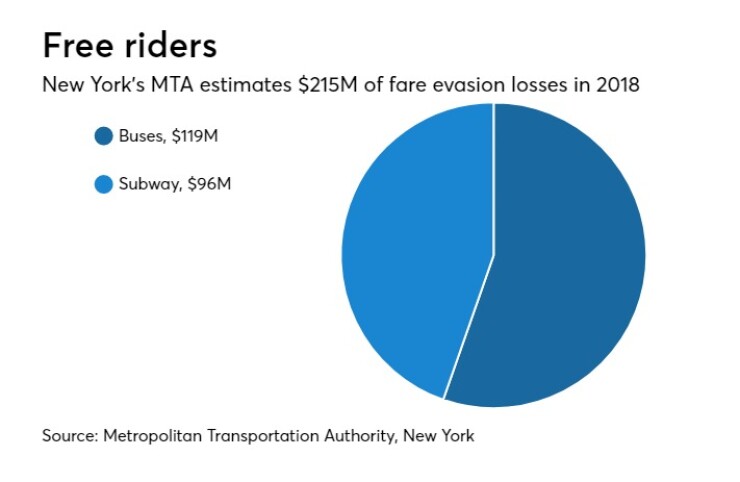The Metropolitan Transportation Authority is chugging through budget season with a plate of challenges as crowded as its New York trains at rush hour.
The MTA, one of the largest municipal issuers with roughly $40 billion in debt, is staring at huge outyear budget deficits, capital financing uncertainty, state-city political conflict over funding, endless service breakdowns and delays, ridership reductions, lost revenue from fare evasions and a public antsy about another looming round of fare and toll increases.

In addition, its chairman, Joseph Lhota, quit abruptly last month.
Even the MTA's special finance committee meeting to review the 2019 operating budget, on which the board must vote next week, started late Monday because its chairman, Lawrence Schwartz, was stuck on a stalled train.
"That's the truth," he said.
The state-run authority, which operates the city’s subways and buses, Long Island and Metro-North commuter railroads, and several bridges and tunnels, faces outyear budget shortfalls that could reach $1 billion in 2022 even if its board, as expected, approves biennial fare and toll increases.
The MTA, which operates on a calendar-year budget, balanced its 2018 spending plan only through such one-shots as drawing down from its general reserve, reducing its capital plan commitment and restricting non-essential spending. Other tweaks range from cuts in off-peak service to tweaking air conditioning and heating.
The authority's board is scheduled to vote on its 2019 operating budget next week.
"The $16.7 billion budget is a disaster," said Nicole Gelinas, a senior fellow at the Manhattan Institute for Policy Research.
Andy Byford, president of the MTA's New York City Transit subdivision, underscored the urgency.
"Everyone understands the MTA does have a very difficult financial situation at the moment," he said. "We are facing quite challenging — quite scary, even — revenue positions in future years."
The capital markets have taken notice.
S&P Global Ratings downgraded the MTA twice in five months, bringing it to A from AA-minus, citing weaker debt-service coverage. Debt service now totals about 16% of the MTA's budget and could reach 20% soon. New York City, by contrast, caps debt service at 15%.
"The debt issue just drives me crazy," said board member David Jones. "This becomes ultimately dangerous [with] the volatility of the markets and the ability to get new debt instruments. I'm getting worried about it."
On Tuesday, Byford pitched members of the City Council's transportation committee for support for his plan to repair and modernize the system, called Fast Forward. The overall tab for the 10-year improvement plan, depending upon estimates, could reach $60 billion.
"The key now, between now and spring, is to convince [leaders] in both Albany and City Hall and for that matter, in Washington for the feds, that this is a plan worth investing in," Byford said in the City Hall rotunda.
One remedy, though Byford stressed it's no panacea, could be a congestion pricing plan to toll vehicles at certain Manhattan entry points. The state legislature in Albany could weigh several iterations next year.
"Congestion pricing is a key element of funding Fast Forward," Byford said. "It's not the only solution. There needs to be a number of funding sources.
"It was worked in places like London and places like Stockholm," said Byford, a Briton who once oversaw London's transit system. "It's not the only solution but it's certainly a key part of that jigsaw."
Council transportation committee chairman Ydanis Rodriguez favors both congestion pricing and Mayor Bill de Blasio's proposed millionaire's tax to fund mass transit. Rodriguez also favors more city funding for the MTA, provided the funds go toward city-related maintenance and repair.
Last year's state budget required the city to pay $418 million to cover half the first phase of the Subway Action Plan, a separate initiative Lhota commenced in July 2017 shortly after Gov. Andrew Cuomo declared a state of emergency for the system.
While Byford has cited progress at signal improvement and reducing catastrophic delays, the MTA has fallen short, according to Gelinas.
"The MTA has not yet proved that it can keep up with today’s record residential population, record daytime [working] population, and record tourist population," she wrote in a
Nicole Malliotakis, a state representative from Staten Island and New York's Republican mayoral candidate in 2017, said the MTA erred in the past by favoring trophy projects such as Second Avenue subway and East Side Access over basic maintenance.
Speaking at a fare-hike hearing at the College of Staten Island on Monday night, Malliotakis called the

A politically dicey component to Schwartz's plan would levy tolls on three now-free East River bridges while lowering the tolls for other outer-bridge crossings. Proponents say it could provide $1.5 billion in annual revenue and roughly $15 billion through bonding.
"I'm not 100% on board, but it's a starting point to look for alternative sources of revenue," said Malliotakis, whose district includes parts of Brooklyn.
City Council member Carlos Menchaca called de Blasio's priorities out of whack, citing the mayor's support for a Brooklyn-Queens streetcar outside the MTA realm. The project has stalled over funding problems.
"This is a case where the emperor has no clothes," Menchaca said. "Nobody likes this project except the mayor."
Fare evasion has also emerged as a budget- and fare-hike talking point. According to Byford, it will cost the MTA roughly $215 million in 2018.
Board member Jones, the executive director of the antipoverty nonprofit Community Service Society of New York, worries that fare-evasion enforcement will disproportionately affect minority persons.
Jones called the matter a "pink herring."
"Yes, it's there, but we have so many more structural issues that are driving the system's economic problems," he said.





